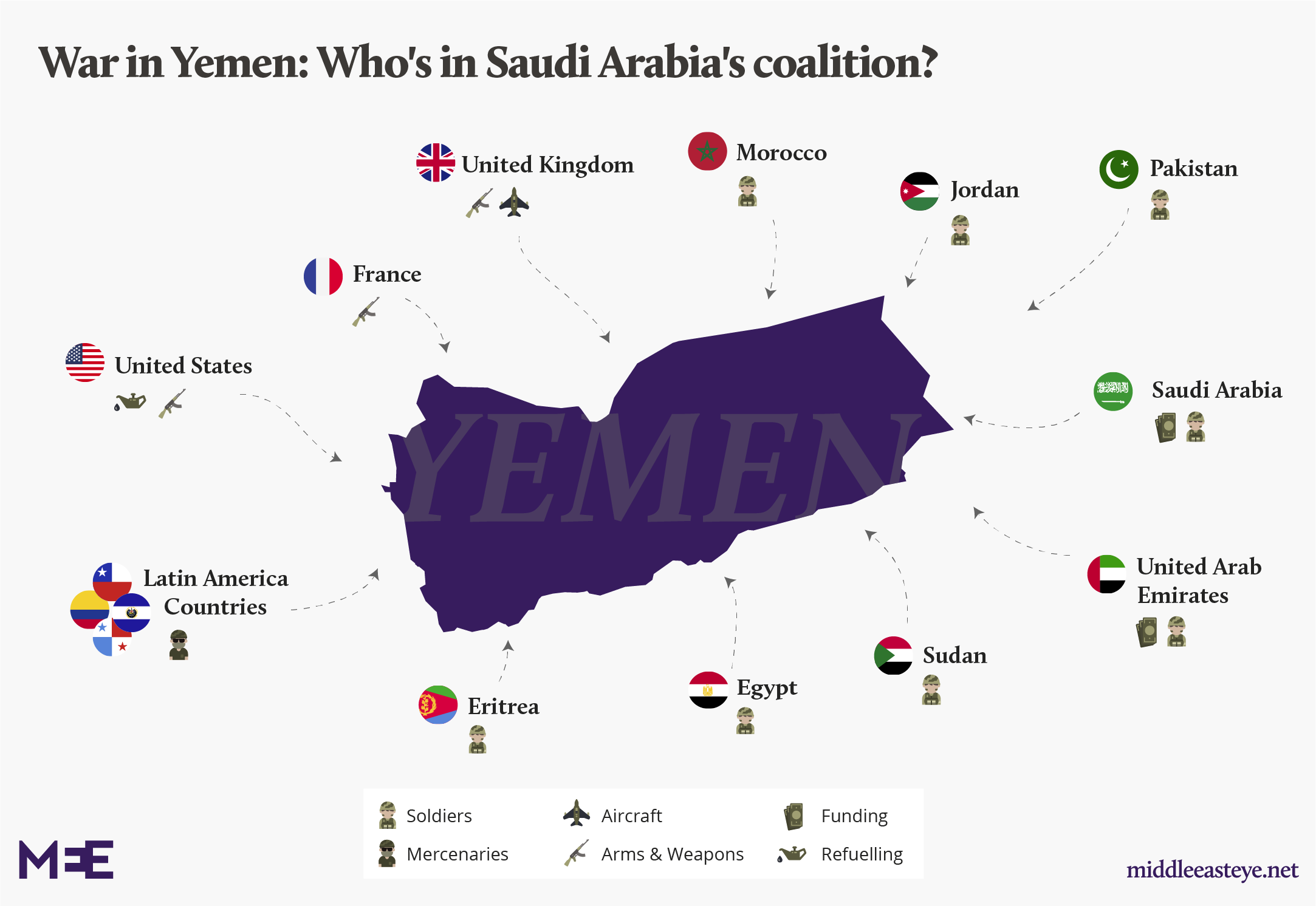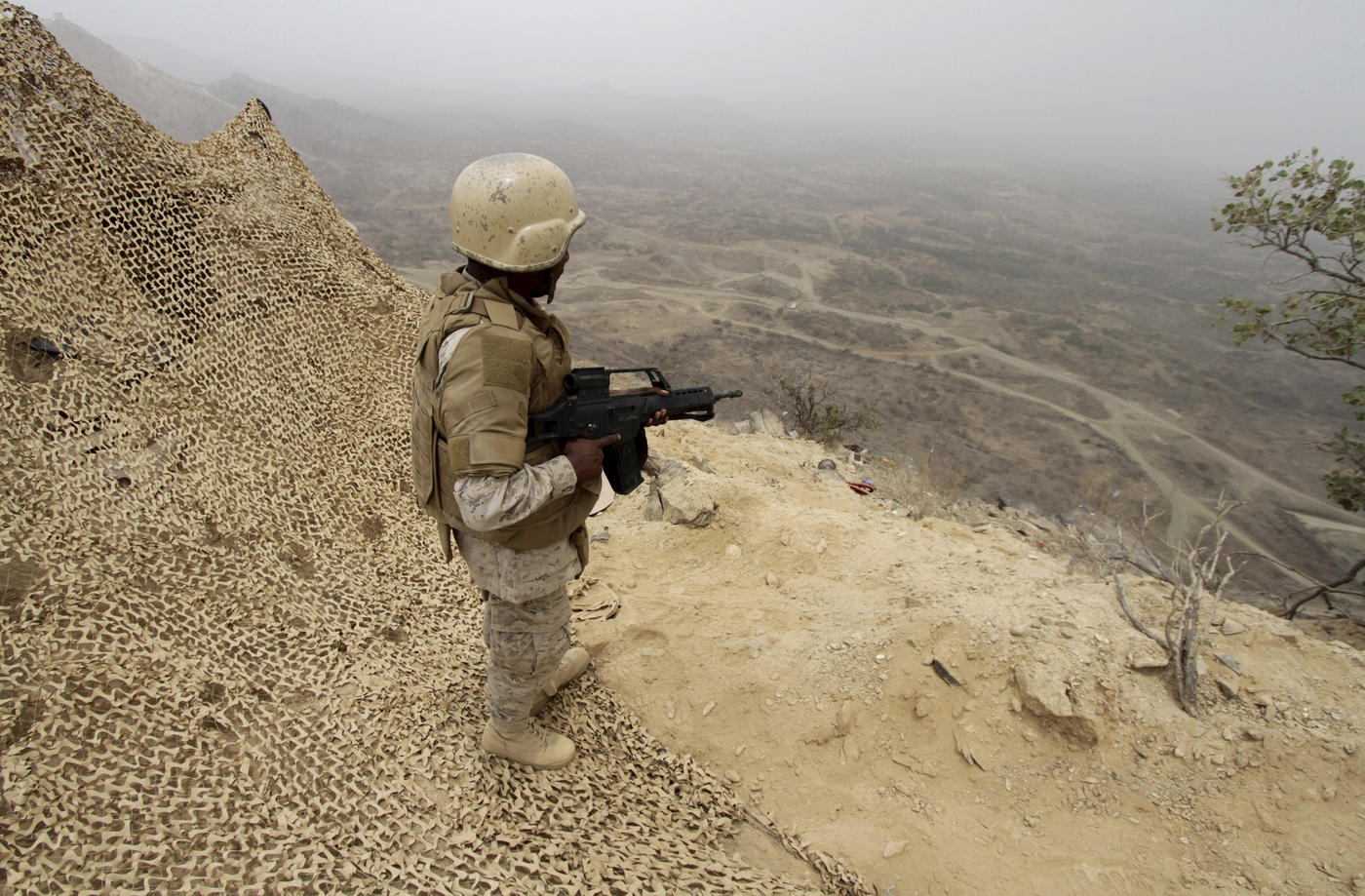Saudi's coalition in Yemen: Militias and foreign mercenaries backed by western firepower
Militia fighters from Darfur and Latin American mercenaries are among those fighting alongside professional soldiers from many Arab nations

Soldiers with the Saudi-led coalition stand guard in the port city of Hodeida on 22 January, 2019 (AFP)
Published date: 28 March 2019
At what point does a regional war become a global one, drawing in the military forces of multiple nations from several continents? In Yemen, that point has long been reached.
Four years since its intervention in Yemen, the Saudi-led coalition continues to draw on military resources from across the Arab and wider world, backed by western-built weapons and technical expertise.
But it is local militias and foreign mercenaries who are taking the fight to Houthi rebels on the ground.
Despite accusations of war crimes and a humanitarian crisis described by the United Nations as the most serious in the world, the collection of nation states formally committed to the coalition has remained relatively stable since 2015.
Arab forces
Among the Gulf Cooperation Council states, the United Arab Emirates, Bahrain, Kuwait, and Qatar joined the coalition at its inception.
Egypt, Jordan, Morocco, and Sudan also agreed to join in support of the Saudi campaign. Despite a parliamentary vote against the country’s participation, Pakistan has contributed 1,000 soldiers to reinforce Saudi Arabia’s armed forces.
Only Qatar, which was expelled from the coalition with the onset of a major diplomatic crisis with Saudi Arabia and the UAE in 2017, has withdrawn its participation.

Western forces
Beyond the wider Middle Eastern region, the US, UK and France have all provided substantial support to the coalition.
The United States declared “logistical and intelligence support” at the outset of the campaign and went on to establish a joint US-Saudi planning cell. The US has also provided aerial refuelling to the Saudi and UAE air forces.
In 2017 the Trump administration fast-tracked the sale of precision-guided missiles to Saudi Arabia, and expanded US military cooperation with the Saudi Air Force “on both targeting and the Law of Armed Conflict”, according to an assessment by Christopher Blanchard, and Jeremy Sharp, Middle East advisors at the Congressional Research Service.
Washington has deployed a modest contingent of military personnel on the ground in Yemen as part of ongoing operations against Al-Qaeda in the Arabian Peninsula (AQAP), which holds on to hold territory in northern Hadhramawt governorate and on the southern coast, and militants linked to the Islamic State group.
The US conducted 36 declared air strikes in Yemen in 2018.
The UK has supplied arms worth almost $6.5 billion to the Saudi coalition. The British army has supplied aircraft and maintenance to those aircraft throughout the campaign.
British and American military personnel are stationed inside command rooms in Riyadh. Earlier in March, reports emerged that claimed five British Special Boat Service commandos had been wounded fighting in Yemen, although a spokesperson for the Ministry of Defence denied the report.
Yemen militias
In addition to national armed forces, a network of both local and sub-national forces are fighting in support of the coalition.
The National Resistance Forces, a Yemeni force led by General Tariq Muhammad Abdullah Saleh, nephew of late president Ali Abdullah Saleh, is currently fighting for the coalition with UAE backing. The National Resistance Forces supported the Houthis until Ali Abdullah Saleh was killed by his former rebel allies in 2017.
Sub-national forces, some drawn from the Yemeni security forces, play a major role in the coalition’s infantry campaign.
A number of Yemeni militias have received direct backing from Saudi Arabia or the UAE, including the Al Hizam brigades, the Shabwani Elite Forces, the Al Amaliqah brigades, the Abu Abbas brigade, Islahi militias, the Tihamah Resistance, and the Yusran Al Maqtari militia.

Former students of the Dar Al Hadith religious school in northern Saadah province have frequently been drafted into militias fighting with the coalition. Yemeni tribal confederations have fought consistently with the coalition since 2015.
African soldiers
Foreign military forces have also been incorporated into national and subnational military divisions in Yemen.
Around 400 Eritrean soldiers are currently believed to be embedded with the UAE armed forces.
Sudan has provided the largest number of foreign troops to the coalition. Approximately 14,000 Darfur militiamen have been fighting in Yemen in tandem with local militia.
These Sudanese fighters have been drawn principally from the Rapid Support Forces, a tribal paramilitary group aligned with the Sudanese government and previously known as the Janjaweed. The Sudanese fighting with the Saudi coalition are often survivors of the Darfur conflict, and have been accused of incorporating children in their ranks.
South Americans
In addition to foreign military forces, the Saudi-led coalition also includes private military contractors, also known as mercenaries.
The largest contingent are Latin American mercenaries made up of fighters from Colombia, Panama, Chile and El Salvador under the general direction of Oscar Garcia Batte, a former Colombian special operations commander.
In 2015 and 2016, an American mercenary company, the Spear Operations Group, worked with the United Arab Emirates on combat operations within Yemen.
A former contractor told Buzzfeed News that ex-special forces soldiers had been hired to carry out a covert assassination programme targeting leaders of the al-Islah movement, the local branch of the Muslim Brotherhood.
While sporadic conflicts continue across the country, two major sieges, of Hodeidah and Taiz, form major fronts.
However Saudi forces keep a presence as deep into Yemen as Al Mahrah province, a south-eastern governorate far from the frontlines.
The main Houthi stronghold in the northern Saadah governorate has faced more Saudi air strikes than any other part of the country since the war began.
Since November 2017, the coalition has also enforced a naval blockade of all Yemeni ports, worsening the humanitarian crisis.
Huge costs
During the conflict, Saudi Arabia and the UAE have both greatly increased military expenditure.
Saudi Arabia currently has the third largest military budget in the world. The UAE military budget is currently unknown, but its military spending is estimated to be the 14th largest in the world.
“The incursion has obviously been essentially destructive, and in terms of resolving the problems one way or the other it has been a total failure,” said Gilbert Achcar, professor of international relations at SOAS, University of London.
According to Achcar, while the Saudi government intended the intervention to be brief and limited, it has developed into a quagmire for Saudi Arabia.
'The incursion has obviously been essentially destructive, and in terms of resolving the problems one way or the other it has been a total failure'- Gilbert Achcar, SOAS
“The Saudis and the other main partner of this intervention, the UAE, do not see eye to eye on everything, far from it – tensions have developed between them,” he said.
While Saudi Arabia has been more interested in shoring up Hadi government forces, the UAE has pursued separate goals in the conflict, such as supporting the secessionist Southern Movement.
According to Achcar, the UAE may be seeking to establish permanent bases in southern Yemen as a route to greater influence in the Gulf region as a whole.
The human extent of human rights violations committed during the conflict is difficult to describe, says Osamah Alfakih from Mwatana, a Yemeni human rights organisation.
“The number of indiscriminate attacks on civilians is very large, especially from air strikes that indiscriminately target civilians, hospitals, even funerals,” Alfakih told MEE.
Mwatana has documented more than 300 air strikes since the beginning of the conflict. “Civilian deaths have been in the thousands,” Alfakih said.
Proxy forces tied to the UAE have been repeatedly accused of serious human rights violations, particularly in southern Yemen.
However, human rights violations, including arbitrary detention, enforced disappearance, and torture have been committed by all sides in the conflict.
“The cost that the people have paid in this war is huge,” Alfakih told MEE. “I don’t know how many years it would take to recover from all that has happened.”
https://www.middleeasteye.net/news/saudis-coalition-yemen-militias-and-foreign-mercenaries-backed-western-firepower


0 Comments:
Post a Comment
Subscribe to Post Comments [Atom]
<< Home